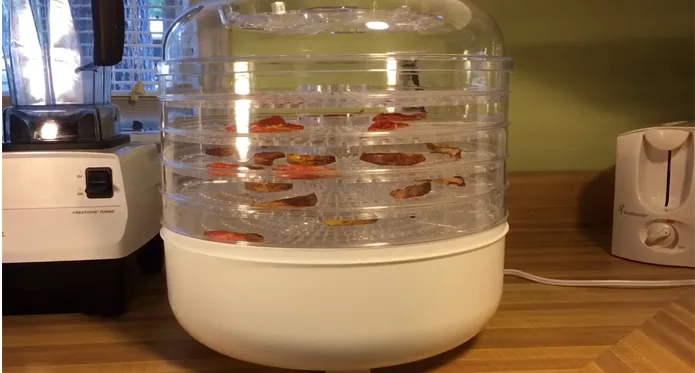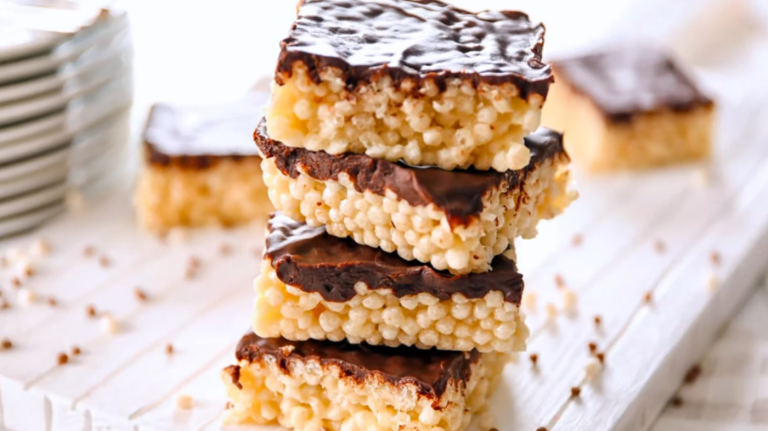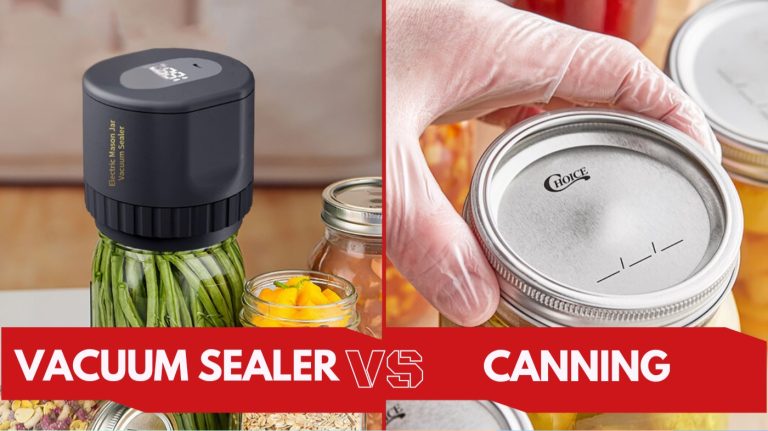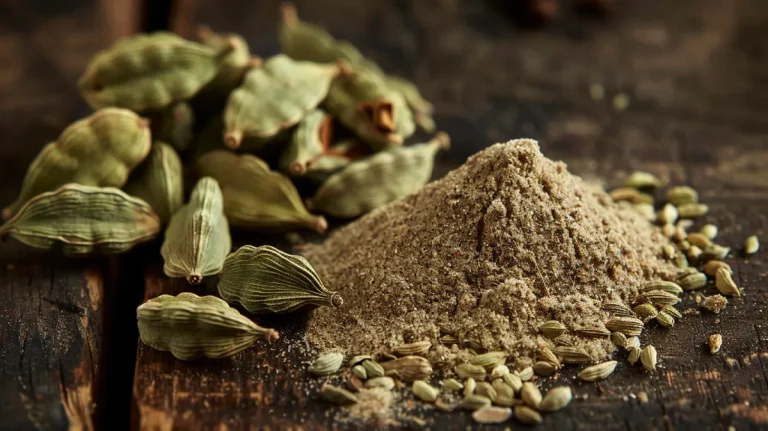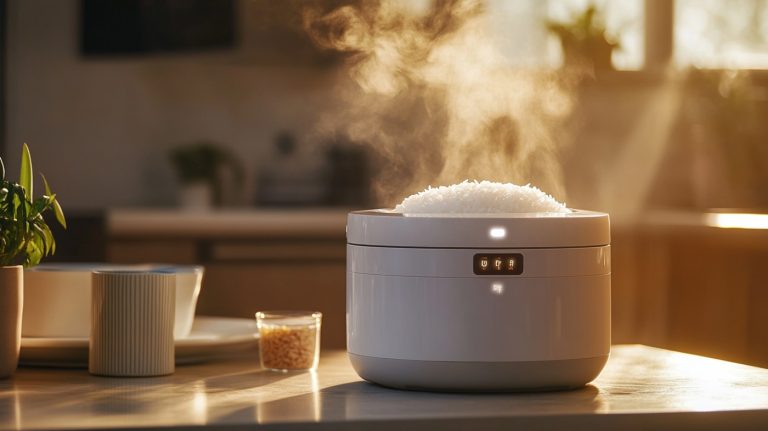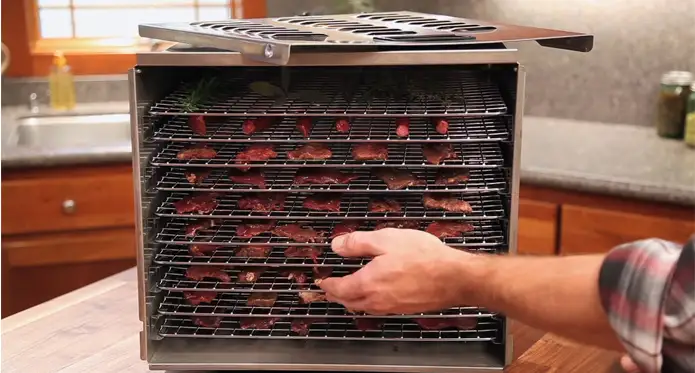Why did My Food Dehydrator Stopped Working : 4 Precautions
Food dehydrators are highly desirable kitchen appliances that extend the shelf life of food. The removal of moisture from food slows down the growth of bacteria and other microorganisms. Also, water taken out of the body during the dehydration process concentrates nutrients.
This process will stop if the dehydrator stops working, and food may spoil more quickly and become unsafe to consume. Thus, you need to determine why your food dehydrator stopped working and get it working again.
When these food dehydrators malfunction, it may be hard to identify the cause. Some foods may lose their nutritional value without dehydration if a food dehydrator is not functioning properly. Keep reading to understand why your food dehydrator isn’t working and how to clean and maintain it.
Why Did My Food Dehydrator Stopped Working : Reasons
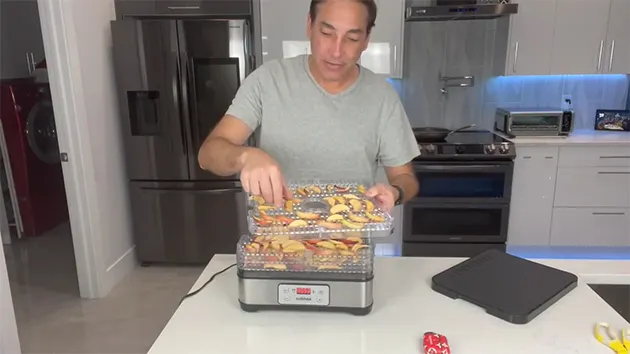
A food dehydrator is a handy appliance in any kitchen, especially if you like to make snacks or preserve herbs and spices. But there could be several reasons behind the failure of your food dehydrator. Here are some of the most common reasons:
When a Food Dehydrator is Not Working
Stuck Food in Fan Blades:
One of the most common problems with food dehydrators is that bits of food get stuck in the fan blades and cause the machine to jam. This can be a significant problem, preventing the dehydrator from working correctly.
If you do find that food has become stuck in the fan, it is often possible to remove it by carefully disassembling the machine and cleaning the fan blades. An easy fix, this problem can be avoided by ensuring your dehydrator is clean, and you aren’t overloading the trays.
Overloading the trays can also cause other problems down the line, so while it might be tempting to fit as much as possible on each dehydrator tray, doing so could end up costing you more in the long run if it damages your machine.
Overheating:
If your food dehydrator has stopped working, it is likely due to a problem with the fan. The fan is responsible for circulating air throughout the dehydrator and keeping the temperature stable. If the fan is broken or jammed, it can cause the dehydrator to overheat.
You can check the fan by opening the dehydrator and looking for any obstructions. If the fan looks damaged, it may need to be replaced. You can also check the fuses inside the dehydrator.
Blown Fuse:
Dehydrators are simple machines that can malfunction for a blown or dead fuse. Even if your model doesn’t have a heating element, it has at least one fuse. Dead fuses will prevent either the fan or the heating element from working and must be replaced.
The majority of fuses are fairly easy to replace. You should check the fuses of your dehydrator once it has been opened. You’ll be able to tell if a fuse has blown if there is a dark streak or gap in the glass.
To replace it, you should remove it and identify its size and type. With a new fuse, your dehydrator should be up and running again.
Tripped Breaker:
Some models of dehydrators come equipped with breakers, which are designed to prevent damage from overheating or large power spikes. If your dehydrator has stopped working after a blackout, the internal breaker will likely be tripped.
To reset the breaker, unplug the dehydrator and let it cool down completely. Then, access the breaker inside the appliance’s chamber and flip the switch to the “On” position.
Once the breaker has been reset, your dehydrator should be fully functional. Be careful when performing this repair and ensure the appliance is completely cool before proceeding.
When a Food Dehydrator is Not Heating Up?
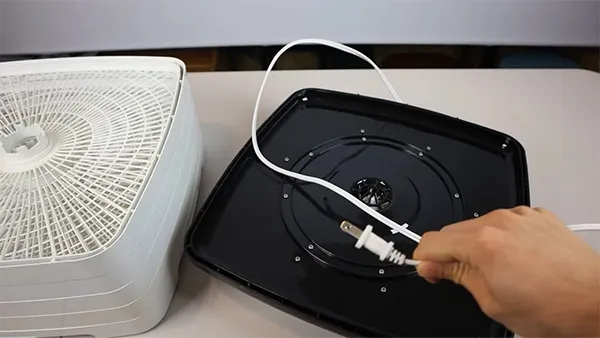
Overloaded Dehydrator:
Your food dehydrator is designed to dehydrate a specific amount of food per batch. If you overload it, the food will not dehydrate evenly.
To avoid this, only put the recommended amount of food in your dehydrator per batch. You can find this information in the user manual. Following the measurement in the user manual ensures that your food turns out perfectly every time.
Disconnected Heater Wire:
Whenever your food dehydrator fails to work, one possible reason is that the heater wire is disconnected or frayed. This wire connects the fuse to the heating element; it can come loose or break over time.
The wire at the back of the appliance might need to be reconnected or replaced if this is the problem. Remove the screws at the back to expose the wire. This is a relatively simple repair that you can do yourself, but if you are not confident in your abilities, you should contact a professional for help.
Faulty Heating Element:
The heating element in a food dehydrator is responsible for converting electrical energy into heat. If the heating element stops working, the dehydrator will either not produce heat or too much heat.
You can check and repair the faulty heating element by unplugging the appliance and allowing it to cool down. Unscrew the screws located at the back of the device with a screwdriver. Remove the outer metal panel to access the fan and fuse, the heating element, and the heater wire.
Make sure you have comfortable access to the heating element and use a multimeter to verify that it is continuous. If you confirm that the heating element is defective, it must be replaced. When working with electricity, ensure that all safety precautions are followed.
Broken Thermostat:
If your food dehydrator suddenly stops working, the issue could be a broken thermostat. The thermostat is responsible for monitoring the heat levels and ensuring that the food doesn’t get too dried or burnt. When it fails, the heating element won’t know when to stop and will overheat the appliance.
Observe the problem to determine whether the thermostat is the problem while the dehydrator is running. If the thermostat stays at the same temperature (whether hot or cold), then it’s likely broken. The thermometer dial and heating element must be connected to a replacement thermometer.
While thermometers are relatively easy to find, wiring them appropriately can be more challenging. If you’re uncomfortable doing this yourself, you may need to hire an electrician.
What Happens When a Thermal Fuse Blows on a Food Dehydrator?
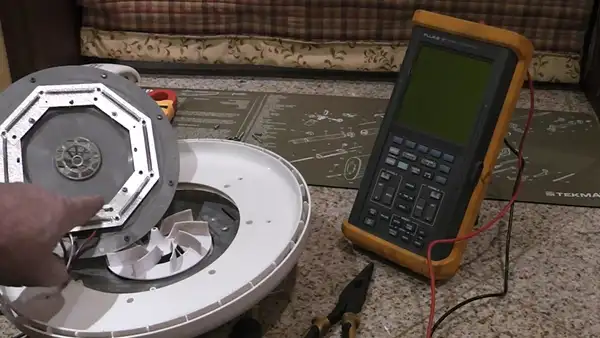
Thermal fuses are an essential safety feature for food dehydrators. They are designed to shut off the flow of electricity if the temperature gets too high. This can happen if the dehydrator is overloaded or if there is a problem with the heating element.
If a thermal fuse blows, the dehydrator will no longer generate heat because when this happens, the flow of electricity to the heating element is cut off, and the dehydrator will no longer work. This can be a significant inconvenience, as you must replace the fuse before the dehydrator works again.
How Do I Know if My Food Dehydrator is Not Working?
If you own a food dehydrator, you may wonder how you can tell if it works as it should. After all, dehydrators rely on heat to remove moisture from food; if the temperature is too low, the food will not dehydrate correctly.
Fortunately, there are a few simple steps to test your dehydrator and ensure it is up to the task:
- Place a thermometer or probe inside the machine when it is empty & run the dehydrator for at least 15 minutes to allow it to warm up and come to internal temperature fully.
- Now check the readings on your thermometer or probe. Most food dehydrators should reach a temperature between 125 and 160 degrees Fahrenheit. If your machine is not reaching these temperatures, it may be malfunctioning.
- Also, you can try dehydrating food in a small amount. If the food does not dehydrate properly or takes longer than usual to dry out, this could be a sign that your machine is not working correctly.
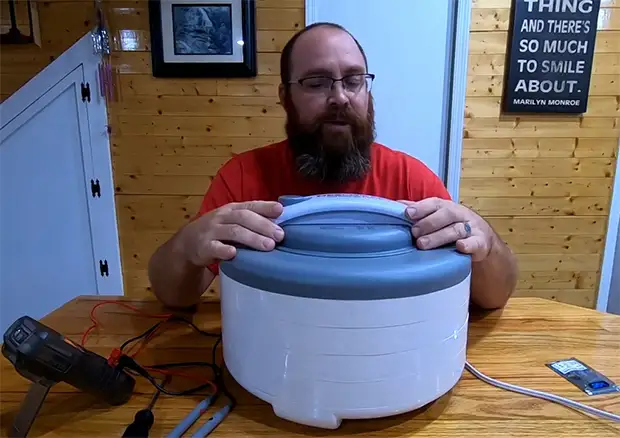
Following these simple steps ensures that your food dehydrator is working properly or not. If your food dehydrator is not reaching the correct temperatures or drying food correctly, you must identify why and fix the problem.
How to Tell if a Food Dehydrator’s Thermal Fuse has Blown?
A blown thermal fuse may be responsible for a malfunctioning food dehydrator. This tiny device is designed to shut off the power to the dehydrator if it begins to overheat. As a result, it can help to prevent fires and other accidents.
When a thermal fuse has blown out, there are a few things to look for:
- Look for any obvious signs of damage, such as scorch marks or burned wiring.
- Inspect the heating element to determine if it is still in good condition.
- Check the temperature control knob to see if it’s set correctly.
- Use a multimeter to measure the resistance of the fuse.
If the fuse has blown out, it would need to be replaced. You can identify and fix any problems by troubleshooting your food dehydrator.
Can I Replace a Blown-Out Fuse Myself on a Food Dehydrator?
Yes, you can replace a blown-out fuse on a food dehydrator yourself. The process is relatively simple and only requires a few tools. You will need to identify the blown-out fuse in the dehydrator.
This can be done by visual inspection. Next, you will need to remove the old fuse and install the new one. Make sure that the new fuse is adequately rated for the food dehydrator.
After replacing the fuse, test the food dehydrator to ensure it works properly. If you have any questions or concerns, consult an appliance repair professional. You can easily change a blown fuse with a little bit of knowledge and effort.
Can You Run a Food Dehydrator Too Long?
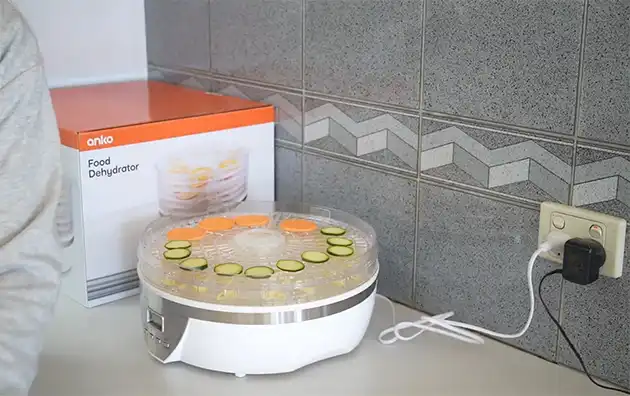
When it comes to food safety, there are a lot of old wives’ tales out there. For example, you may have heard that you should never put hot food in the refrigerator or reheat leftovers.
But, one of the most persistent myths is that you can’t run a food dehydrator for too long. The truth is, you can overrun a food dehydrator, but it can have some pretty serious consequences.
If you over-dehydrate food, it can become brittle and dry. This reduces its nutritional value and makes it more susceptible to spoilage. Also, over-dehydrated food can be a choking hazard, particularly for small children.
So if you’re using a food dehydrator, follow the instructions carefully to avoid these potential hazards.
Can a Food Dehydrator Overheat if I Run it Too Long?
Dehydrators work by circulating warm air over food to remove the moisture, and they can be set to run for long periods. But, some wonder if it is possible to overheat a food dehydrator. The answer is yes; food dehydrators can overheat if left running for too long.
When the temperature is too high, it can cause the food to scorch or burn. Also, there is the possibility of damage to the appliance itself. Consequently, you should carefully monitor your dehydrator’s temperature and turn it off if it gets too hot.
Is it Safe to Run My Food Dehydrator Overnight?
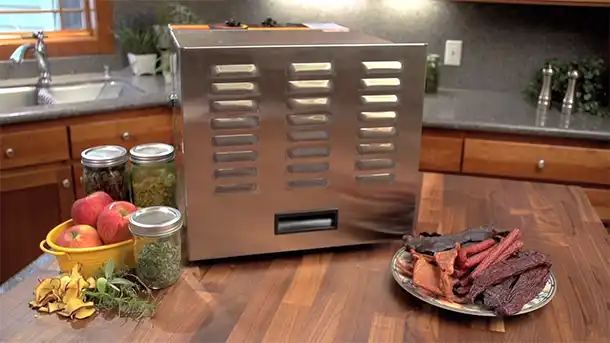
All dehydrators come with a timer, and it is vital to set this for the recommended time. This is because some foods need to be dehydrated for longer than others. For example, thicker cuts of meat will take longer to exhaust than thin slices of fruit.
If you try to hurry the process, dehydrators are powered by electricity, and as with any electrical appliance, there is always a fire risk. But, you can significantly reduce this risk by following a few simple safety precautions:
- Make sure that your dehydrator is in a well-ventilated area. This will help to prevent any build-up of heat or fumes.
- Inspect your dehydrator regularly for any signs of damage. If you notice frayed wires or cracked guards, discontinue use immediately and contact the manufacturer.
- Never cover your dehydrator while it is in use. This could cause it to overheat and pose a severe fire hazard.
These simple guidelines will help ensure that your dehydrator is safe to use overnight.
What Temperature Does a Food Dehydrator Run at?
Dehydrators typically run at a temperature of around 140 degrees Fahrenheit, which is hot enough to evaporate moisture but not so hot that it cooks the food.
They work by extracting moisture from food, which helps prevent bacteria and mold growth. Since moisture is essential for developing microorganisms, dehydrated foods have a much longer shelf life than their fresh counterparts.
How to Properly Clean and Maintain a Food Dehydrator?
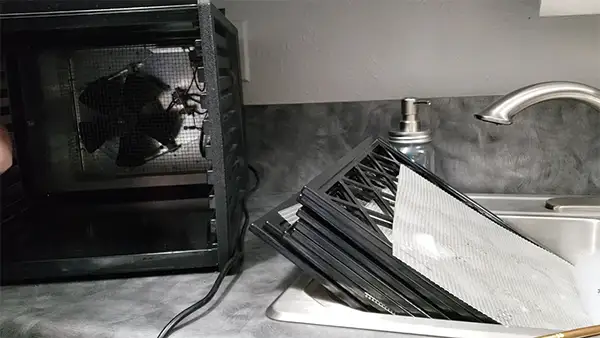
Any food-loving household needs to maintain and clean a dehydrator. While a dehydrator is an excellent addition to any kitchen, it requires care and maintenance to keep it running correctly.
Here are a few tips on cleaning and maintaining your food dehydrator:
- Make sure to clean the trays and lid after each use. Wipe down the trays with a damp cloth or brush off debris. The lid can be cleaned with mild soap and water. Thoroughly dry all parts before putting them back in the dehydrator.
- Regularly check the seals on the dehydrator. Over time, the seals can become cracked or damaged, which can cause moisture and heat to escape. If you notice any damage, replace the seals immediately.
- When the dehydrator is not in use, it should be kept in a cool, dry location. Exposure to moisture and heat can cause damage to the unit. If you’re not using your dehydrator for an extended period, unplug it and store it in a cool, dry place.
You can extend the life of your best food dehydrator by following these simple tips.
You Might Want to Check:

